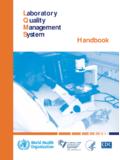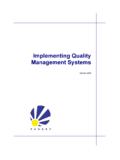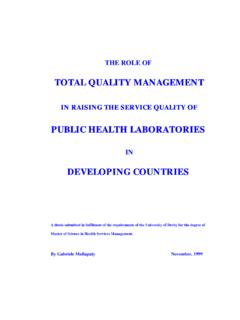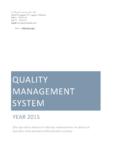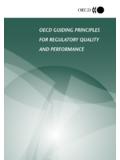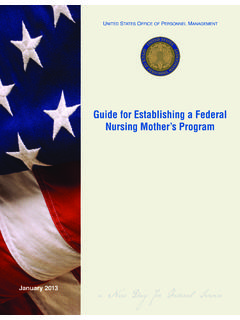Transcription of Risk Management and Quality Improvement …
1 EQuIPNational Resource RISK Management & Quality Improvement . HANDBOOK. Risk Management and Quality Improvement Handbook, July 2013. Produced by the Australian Council on Healthcare Standards (ACHS). Copies available from the ACHS website: Copyright the Australian Council on Healthcare Standards (ACHS). This work is copyright. Apart from any use as permitted under the Copyright Act 1968, no part may be reproduced by any process without prior written permission from The Australian Council on Healthcare Standards. Requests and enquiries concerning reproduction and rights should be addressed to the Chief Executive, The Australian Council on Healthcare Standards, 5 Macarthur Street, ULTIMO NSW 2007 Australia.
2 Telephone: 61 2 9281 9955. Facsimile: 61 2 9211 9633. Recommended citation: The Australian Council on Healthcare Standards (ACHS), Risk Management and Quality Improvement Handbook. Sydney Australia; ACHS; 2013. First edition (EQuIP 4): 2007. Second edition (EQuIP5): 2011. Third edition (EQuIPNational): 2013. This Handbook is only available via the ACHS website and may be revised annually. In this case, the version number and date in the footer will change. ISBN 13: 978-1-921806-46-9. Developed by Deborah Jones Manager, Standards and Program Development The Australian Council on Healthcare Standards. The ACHS would like to thank the following people for their time and expertise in reviewing the content of this document.
3 Cathy Balding, Vince Gagliotti, Elizabeth Kingsley Director, Qualityworks P/L ACHS Surveyor, Quality ACHS Project Officer Manager, St Vincent's Standards and Product Joy Brumby, Hospital, Melbourne Development ACHS Education Manager Sue Gilham, Ros Pearson, Gillian Clark, ACHS Survey Coordinator ACHS Contracted Survey ACHS Education Coordinator Consultant Kaye Hogan, ACHS Survey Coordinator Sandy Thomson, Karen Edwards, ACHS Contracted Survey ACHS Surveyor, CEO / Coordinator DON Calvary Health Care Sydney Page 2 of 81. Copyright The Australian Council on Healthcare Standards (ACHS). Risk Management and Quality Improvement Handbook.
4 EQuIPNational. July 2013. Contents Definitions .. 5. Introduction .. 6. The EQuIPNational Framework .. 6. The EQuIPNational Standards .. 7. Risk Management and Quality Improvement .. 8. Developing a Commitment to Risk Management and Quality Improvement using EQuIPNational.. 9. Incorporating Risk Management and Quality Improvement into Organisational Planning .. 10. Section 2 .. 12. Creating an Improving Organisation .. 12. Organisational Culture and Change Management .. 12. The change model .. 15. Team building .. 18. Summary .. 19. Section 3 .. 20. Risk Management 20. Risk Management System Requirements .. 20. Responsibilities and Accountabilities.
5 23. Risk Management Resources .. 24. Risk Management Processes and Strategies .. 26. The Risk Register .. 29. Summary .. 32. Section 4 .. 33. Quality Improvement .. 33. Quality Cycle .. 33. Quality Improvement Essentials .. 36. Identifying Areas Requiring Improvement .. 41. Sentinel events, adverse events and root cause analysis .. 41. Incident monitoring .. 44. Page 3 of 81. Copyright The Australian Council on Healthcare Standards (ACHS). Risk Management and Quality Improvement Handbook. EQuIPNational. July 2013. Gap analysis .. 45. Surveys .. 46. Patient feedback systems .. 47. Rapid appraisals .. 48. Audits.
6 49. Accreditation survey results and recommendations .. 50. Clinical indicators .. 51. Patient journey surveys .. 52. Benchmarking .. 53. Summary .. 57. Section 5 .. 58. Quality Improvement 58. Using the Right Tool for the 58. Identifying the current steps in a process .. 59. Analysing the process .. 59. Planning solutions to improve the process .. 59. Measuring improvements .. 60. Affinity diagrams .. 61. Bar charts / graphs .. 62. Brainstorming .. 63. Cause and Effect (Fishbone) .. 64. Control 64. Failure Mode Effects Analysis (FMEA) .. 65. Flow charts .. 68. Histograms .. 70. Pareto 70. Run charts / line graphs.
7 72. Section 6 .. 73. Evaluation .. 73. Structure, process and outcome .. 75. Structure .. 76. Process .. 76. Outcome .. 77. Conclusion .. 78. Page 4 of 81. Copyright The Australian Council on Healthcare Standards (ACHS). Risk Management and Quality Improvement Handbook. EQuIPNational. July 2013. Definitions 1. Quality : the extent to which a health care service or product produces a desired outcome. Quality Improvement : an ongoing response to Quality assessment data about a service in ways that 2. improve the processes by which services are provided to consumers / patients. Quality Improvement Plan: a document that outlines at a minimum what area requires Improvement , how an organisation intends to carry out that Improvement , timeframes and responsibilities.
8 The size, type, complexity and location of the organisation will influence the activities to be undertaken. The Quality Improvement Plan should be provided to ACHS with the self-assessments in the non-survey phases of the accreditation cycle. It should also be available for surveyors to review at any onsite surveys. 3. Risk: the effect of uncertainty on objectives. A healthcare organisation's objectives have different aspects, such as clinical, financial, health and safety or environmental, and they apply at the strategic, organisation-wide, unit, project or process levels. In the context of risk, uncertainty is defined as the state, even partial, of deficiency of information related to understanding or knowledge of an event, its consequence, or likelihood.
9 Any deviation from the expected can result in a positive and/or negative effect. Therefore, any type of risk, whatever its nature, may have either (or both) positive or negative consequences. 3. Risk Management : the coordinated activities to direct and control an organisation with regard to risk. Risk Management process: the systematic application of Management policies, procedures and practices to the activities of communicating, consulting, establishing the context, and identifying, 3. analysing, evaluating, treating, monitoring and reviewing risk. Risk Register: a centralised record that identifies for each known risk: a description of the risk, its causes and its impact an outline of the existing controls, including the person accountable for managing the risk an assessment of the consequences of the risk should it occur and the likelihood of the consequence occurring, given the controls a risk rating an overall priority for the risk.
10 Page 5 of 81. Copyright The Australian Council on Healthcare Standards (ACHS). Risk Management and Quality Improvement Handbook. EQuIPNational. July 2013. Introduction This document is the Risk Management and Quality Improvement Handbook. It is designed to complement the EQuIPNational programs of The Australian Council on Healthcare Standards (ACHS) by providing information to assist member organisations with the development of their Quality Improvement Plan and Risk Register, which are requirements of the EQuIPNational program, and the National Safety and Quality Health Service (NSQHS) Standards program. This publication is available from the members' section of the ACHS website as an eBook.
